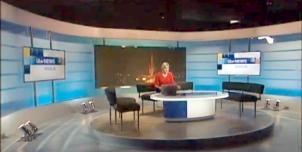Full Freeview on the Sudbury (Suffolk, England) transmitter
| Google Streetview | Google map | Bing map | Google Earth | 52.005,0.786 or 52°0'17"N 0°47'8"E | CO10 5NG |
The symbol shows the location of the Sudbury (Suffolk, England) transmitter which serves 440,000 homes. The bright green areas shown where the signal from this transmitter is strong, dark green areas are poorer signals. Those parts shown in yellow may have interference on the same frequency from other masts.
This transmitter has no current reported problems
The BBC and Digital UK report there are no faults or engineering work on the Sudbury (Suffolk, England) transmitter._______
Digital television services are broadcast on a multiplexes (or Mux) where many stations occupy a single broadcast frequency, as shown below.
64QAM 8K 3/4 27.1Mb/s DVB-T MPEG2
H/V: aerial position (horizontal or vertical)
The Sudbury (Suffolk, England) mast is a public service broadcasting (PSB) transmitter, it does not provide these commercial (COM) channels: .
If you want to watch these channels, your aerial must point to one of the 80 Full service Freeview transmitters. For more information see the will there ever be more services on the Freeview Light transmitters? page.
Which Freeview channels does the Sudbury transmitter broadcast?
If you have any kind of Freeview fault, follow this Freeview reset procedure first.Digital television services are broadcast on a multiplexes (or Mux) where many stations occupy a single broadcast frequency, as shown below.
64QAM 8K 3/4 27.1Mb/s DVB-T MPEG2
H/V: aerial position (horizontal or vertical)
The Sudbury (Suffolk, England) mast is a public service broadcasting (PSB) transmitter, it does not provide these commercial (COM) channels: .
If you want to watch these channels, your aerial must point to one of the 80 Full service Freeview transmitters. For more information see the will there ever be more services on the Freeview Light transmitters? page.
Which BBC and ITV regional news can I watch from the Sudbury transmitter?

BBC Look East (East) 0.8m homes 3.2%
from Norwich NR2 1BH, 77km north-northeast (24°)
to BBC East region - 27 masts.
70% of BBC East (East) and BBC East (West) is shared output

ITV Anglia News 0.8m homes 3.2%
from NORWICH NR1 3JG, 78km north-northeast (24°)
to ITV Anglia (East) region - 26 masts.
All of lunch, weekend and 80% evening news is shared with Anglia (West)
Are there any self-help relays?
| Felixstowe West | Transposer | 1000 homes +1000 or more homes due to expansion of affected area? | |
| Witham | Transposer | 14 km NE Chelmsford. | 118 homes |
How will the Sudbury (Suffolk, England) transmission frequencies change over time?
| 1984-97 | 1997-98 | 1998-2011 | 2011-13 | 1 Aug 2018 | |||||
| B E T | B E T | B E T | E T | K T | |||||
| C29 | SDN | ||||||||
| C31 | ArqA | ||||||||
| C35 | C5waves | C5waves | |||||||
| C37 | ArqB | ||||||||
| C41 | ITVwaves | ITVwaves | ITVwaves | D3+4 | D3+4 | ||||
| C44 | BBC2waves | BBC2waves | BBC2waves | BBCA | BBCA | ||||
| C47 | C4waves | C4waves | C4waves | BBCB | BBCB | ||||
| C51tv_off | BBC1waves | BBC1waves | BBC1waves | ||||||
| C56tv_off | ArqB | ||||||||
| C58tv_off | SDN | ||||||||
| C60tv_off | -ArqA |
tv_off Being removed from Freeview (for 5G use) after November 2020 / June 2022 - more
Table shows multiplexes names see this article;
green background for transmission frequencies
Notes: + and - denote 166kHz offset; aerial group are shown as A B C/D E K W T
waves denotes analogue; digital switchover was 6 Jul 11 and 20 Jul 11.
How do the old analogue and currrent digital signal levels compare?
| Analogue 1-4 | 250kW | |
| SDN, ARQA, ARQB, BBCA, D3+4, BBCB | (-4dB) 100kW | |
| Analogue 5 | (-7dB) 50kW | |
| Mux 2* | (-14.9dB) 8.1kW | |
| Mux B* | (-15.2dB) 7.5kW | |
| Mux 1* | (-15.5dB) 7kW | |
| Mux A* | (-17dB) 5kW | |
| Mux C* | (-22.2dB) 1.5kW | |
| Mux D* | (-23.6dB) 1.1kW |
Which companies have run the Channel 3 services in the Sudbury transmitter area
|
|
Sunday, 28 May 2023
N
nick6:20 AM
Chris SE,
Thanks. Whatever the reason, the new arrangement is far better than when we had muxes on c58 and c60.
Do you know about aerials? I am staggered how good the log periodic is. Perhaps they have been improved over the years. Does each element receive the signal, thus adding to performance? For example, the longest and shortest element also increase the signal for c39, albeit they are the wrong length?
| link to this comment |
Friday, 16 June 2023
Saturday, 17 June 2023
C
Chris.SE12:27 AM
nick:
Hi Nick, sorry, I had seen it and meant to find a couple of articles for you to read, got side-tracked and forgot :(
In essence, all the elements are active but "tuned" to different frequencies.
The Wiki article gives a good basic understanding as does the article from Don Valley Aerials.
Log-periodic antenna - Wikipedia
The log periodic | Don Valley Aerials
There's a BBC R&D article which I haven't has time to read but will no doubt be interesting -
A UHF log-periodic receiving aerial - BBC R&D
As you'll see, and has previously been mentioned, you can produce a log-periodic for whatever frequency range you want.
So still available from some suppliers is the original UHF Band IV/V wideband or Group T which are now getting more difficult to find as they aren't needed any more for UK transmissions, and there's few continental transmitters yet to clear 700MHz
More readily available now is a Group K (21-48) and a Group A (21-37). I don't recall seeing a specific Group B one, little point really as Group K will do the job.
Hope that helps. If I find anything else of specific interest, I'll post it.
| link to this comment |
Sunday, 18 June 2023
N
nick6:55 AM
Chris SE,
Thank you. I will study these. Each element is tuned to its frequency but doubtless all the others get a lesser signal too, adding to overall performance, and doubtless the smaller space between the smaller elements gives some of the advantages of a yagi.
| link to this comment |
Monday, 18 September 2023
A
aytch1:09 PM
Note to Chris and referring back to Jan 2022:
Update - I now have a new telly so my situation has changed.
Just to thank you for your past advice.
| link to this comment |
C
Chris.SE9:14 PM
aytch:
Hi there. Noted, thanks for the update.
| link to this comment |
Friday, 22 September 2023
N
nick 12:13 AM
Chris SE.
I have made what I think is an interesting discovery today testing several aerials at only 6ft from the ground. They all have good reception but they ALL are very poor with regard to signal quality, 33%, on channel 37, right in the middle of the range of channels used by Sudbury. This is presumably why 37 is the first to go on my rooftop aerial. if 47 were poor, or 29 were poor, I could understand it was an aerial problem, but this is a mystery. Any ideas please?
| link to this comment |
C
Chris.SE3:02 AM
nick :
Hi there. I assume you are obviously pointing them at Sudbury.
1) Try a different spot and see if the Quality figure gets better or worse. If it gets worse, you may possibly be getting near some source of interference
2) Try rotating the aerial to different compass bearings and see if you can identify/receive and other signal on C37. You may have to move tyo another spot if buildings get in the way.
3) Try all the above with the aerial polarisation vertical
4) Try with different "in between" polarisations.
Obviously with a number of those, I'd expect the Sudbury signal to reduce in both Strength and Quality, but there may be cases where there's little drop in Signal but significant drop in Quality.
There will be points where the Quality is sufficiently low, the Signal will become zero (it's become just noise or possibly interference).
| link to this comment |
Saturday, 23 September 2023
N
nick 11:34 PM
Chris SE, thanks. I follow your reasoning here. This must be some form of interference, and I suspect from your notes, that it must be that Holland has a troublesome transmitter on this channel.
It is almost impossible to locate my test aerials elsewhere, but I have made further discoveries. Signal quality on 37 improves after dark.
Some of my aerials, during the day, show the quality jumps up from 30 to 90, but then within a second jumps back down..
I have tested several aerials, and the log is second best. The only one that defeats this problem during the day is home made and produces a steady 70 plus quality. Basically it is the old fashioned 18 element group B, but with two parallel groups of 16 directors and a circular dipole about 8 ins diameter. which markedly improves the bandwidth. The directivity may be keeping out the intruder.
| link to this comment |
Sunday, 24 September 2023
C
Chris.SE2:51 PM
nick :
Interesting, but I'm not sure I'd jump to the conclusion that it's Holland at present.
Two things of particular interest about the Quality figures.
1) the brief jump to 90% - does this occur at regular/particular times of day or is it totally random?
2) You mention it improves after dark, by how much, what figures? (This may be related to a bit of temperature inversion of course).
| link to this comment |
Select more comments
Your comment please!




